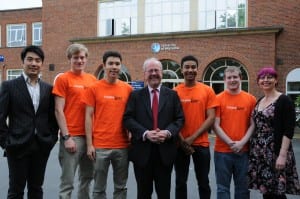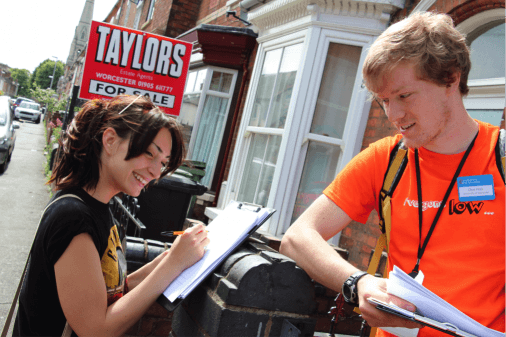Analysis of Consumer Energy Behavior in the Arboretum
| Sponsor: | University of Worcester |  |
| Sponsor Liaisons: | Katy Boom and Peng Li | |
| Student Team: | Charles Frick, Nicholas Lemere, Alexander Shoop, Stefan Smith | |
| Abstract: |
Our project, sponsored by the University of Worcester, established a baseline energy consumption profile of residents within the Arboretum in Worcester, England. We performed door-to-door canvassing, spoke with 240 residents, and received a total of 102 survey responses. We found that residents struggle with energy bills, costs of retrofits, and heating. We recommended that future researchers continue to engage the community, create an educational campaign to teach energy conservation behaviors, and facilitate smart meter implementation within the Arboretum. |
|
| Link: | Analyis of consumer energy behavior in the Arboretum | |
Executive Summary
The rising demand for fossil fuels has driven a surge in the cost of oil, and has forced both consumers and nations to look for ways to reduce their energy consumption. This increase in the cost of oil has a vast impact on the production of goods, transportation, and most importantly the cost of living for many individuals in the world. UK homes are among the least thermally and energy efficient in Western Europe and are responsible for 28% of UK’s total carbon dioxide (CO2) emissions annually. In order to combat this, the government has instituted regulatory programs for citizens to reduce CO2 emissions through energy conservation activities.
The University of Worcester (UW), located in Worcestershire County, UK is working with students, landlords, the Worcester City Council, and other stakeholders in an effort to reduce energy use in residential buildings. Building on a program known as “Student Switch Off,” the University has developed a new initiative called Energize Worcester. This initiative received funding from the National Union of Students (NUS) Student Green Fund to continue the initial student led program.
 Figure 1: A view of Worcester from the Cathedral (Photo: Chas Frick, 2014).
Figure 1: A view of Worcester from the Cathedral (Photo: Chas Frick, 2014).
With the success of the Energize Worcester program, our project sought to expand the Energize Worcester program to non-student residents within the Arboretum of Worcester, a small neighborhood of around 800 residences. Our objectives to achieve this goal were assessing local housing conditions and understanding the community demographic, studying the community perception and attitudes towards sustainability and energy conservation, and assessing the feasibility of educational materials to teach sustainability behaviors to those in this community. In order to implement this project, the University of Worcester has partnered with Worcester Polytechnic Institute (WPI) to develop a baseline energy consumption profile of the Arboretum. To achieve this goal, we worked closely with the Director of Environmental Sustainability for the UW, Katy Boom; the Project Manager of Energize Worcester, Peng Li; the Worcester City Council; and the secretary of the Arboretum Residents Association, member of Transition Worcester and Arboretum resident, Paul Brohan. As an overall goal we aimed to influence consumer behavior to be more sustainable.
Literature Review
Carbon footprint
Every action has an effect on the environment; the extent of the actions is measured by the carbon footprint. Carbon footprints are essentially a measure of the CO2 emissions. The carbon footprint is directly proportional to the amount of CO2 emitted into the atmosphere due to combustion of fossil fuels. According to the website Energy Saving Trust, the UK aims to reduce CO2 emissions by 80%, below the recorded levels in 1990, by the year 2050 (Energy Saving Trust, 2014). One way to accomplish this is to shift towards more carbon efficient forms of technology and reduce the extensive packing and processes behind products (Climate Group, 2008). To help solve the energy efficiency issue, the government has instituted a program known as the “Green Deal.” This “Green Deal” is a financial compensation program where the government “provides energy efficiency improvements to properties at no up-front cost to landlords” (NLA, n.d.).
Consumer Behavior and Direct Feedback
Energy utility companies need to realize that not all consumers will implement energy retrofits inside their homes. For low-income consumers, acquiring expensive but technologically advanced and energy-efficient products may not be their first option. Nonetheless consumers desire low cost options for reducing energy consumption. While cost is important, a “rewards-based incentive program” is a good strategy to use to convince customers to change their energy consumption behaviors (Shaw, 2012).
Direct feedback, with regard to electricity usage, is a strategy where electricity consumption data is provided back to consumers in almost real time (Faruqui et al., 2010b). Hunt Allcott and Sendhil Mullainathan in their article on Behavioral Science and Energy Policy describe how many behavior programs fail because of a lack of feedback of some form (Allcott, 2010). Sarah Darby, in her 2006 literature review on the Effectiveness of Feedback on Energy Consumption, states that “without feedback it is impossible to learn effectively” (Darby, 2006b, p.17). This feedback can be accomplished in a number of ways including using an in-home display in combination with a smart meter or even by simply using the smart meter alone.
Methodology
To start the project we conducted a site assessment, which included mapping who lived in the Arboretum using our house-by-house checklist and a short questionnaire (Appendix H), conducting a main survey (Appendix K), and documenting the external conditions of houses for evidence of solid walls. To better understand the region, we also compiled a listing of all of the Energy Performance Certificates (EPC) on the various properties around the Arboretum. We did this for all of the streets in the Arboretum, and from these EPCs we were able to understand the baseline levels of sustainability for the region in terms of energy efficiency and possible energy retrofits for the properties. As part of our site assessment, we performed a door-to-door canvassing of the Arboretum and initiated our work by distributing 724 leaflets to homes in the area to inform residents of our surveying.
We approached every residence in the Arboretum to find out who lived at each property. In the beginning, the project focused on tenants living in houses of multiple occupancy (HMOs), as defined by the Worcestershire City Council. Due to the low response rate from HMO tenants, we expanded the project to any residents willing to speak with us. We asked interested residents to fill out our main survey and one of our team members can be seen helping a resident work through the survey in Figure 2.
Figure 2: Chas Frick surveying an Arboretum resident (Photo: Alex Shoop, 2014).
Results and Discussion
Site Assessment
Our site assessment revealed a quiet and friendly neighborhood with many solid wall terrace houses dating to the 1890s. We learned that solid wall has several drawbacks when it comes to wall insulation: the insulation becomes costly, physically intrusive into a room and difficult to install. Additionally, solid walls are less thermally efficient than cavity walls. Our site assessment also revealed that despite residents’ best efforts, some homes still experience damp and mold. These are problems that can easily be fixed by proper insulation, by keeping homes at correct temperatures in the winter and by using dehumidifiers.
Housing and Demographics
Part of the project involved EPCs which are required for every property that is rented (excluding HMOs), built or sold. These EPCs are publically available online through a web search using the postal code and address of a property. The important information from an EPC is the current and potential rating of a property. The current and potential ratings of a property score the overall energy efficiency features and retrofit capabilities of a property. Other highlights of an EPC are the cost of living (energy bill cost) in the property, as well as an estimate of the costs to retrofit the property and improve the property’s energy efficiency.
We received 102 survey responses from residents of the 195 surveys that we gave out, resulting in a 52% response rate. Within the group of responses for our survey a majority (62%) of these people owned their homes. Only 38% of respondents rented their homes and only 16% of all respondents rented and shared the property with others.
In terms of demographics of those who responded, a majority were males. Above half of the respondents were 46 years of age and over (almost 58%), and the majority of the responders (84%) were White from the British Isles (i.e. English, Welsh, Scottish or Northern Irish). A solid 50% answered that their income was less than £20,000 a year. This correlates well with the fact that the largest age group of respondents was over the age of 60 and living on pensions.
Perceptions and knowledge of energy conservation
The most common retrofits in the Arboretum are double glazed windows and energy saving light bulbs (mainly compact fluorescents or light emitting diode bulbs). Other less common types of retrofits include energy efficient boilers and loft insulation. We found low levels of wall insulation primarily because of the old Victorian style of solid wall housing.
Our survey also showed that residents generally share an average level of awareness of retrofit technologies and energy saving behaviors, as respondents ranked themselves around 5, “average knowledge,” on a scale of 1, “no knowledge,” to 10, “expert knowledge.” Additionally Figure 3 shows that many residents are aware of and perform many simple energy saving behaviors.
Figure 3: Percentages of respondents performing energy saving actions
From our data, the community profile of the Arboretum is a neighborhood with a diverse but aging populous with varying levels of energy consumption knowledge, and properties that contain various stages of retrofits.
Discussion
Overall the data shows that the community is diverse and perceptive of many retrofits and energy saving behaviors. However, not everyone has installed these technologies due to large expenditures required to purchase energy efficient technology and because many people live on a low income. Some older residents oppose investing in retrofits for their homes because they feel that they will not experience the benefits in their lifetime. Naturally, the available technology must also be taken into account when considering retrofits. As one resident said “just remember the majority of houses in the Arboretum were built before WW1, therefore luxuries like cavity walls and insulated building blocks are out!” (Survey 63). This is important to note when discussing housing conditions as most homes contain solid walls, thus many homes require exterior insulation and cause significant expenses to residents.
A majority of residents does try to monitor their energy consumption however. To aid in this endeavor, about half of the participants want smart meters installed. Some respondents indicated they already owned a smart meter. Other residents indicated they may not have enough information about how a smart meter can benefit them by leaving the “Do you want a smart meter?” survey question blank. We believe others may fear an additional charge on their monthly energy bill caused by the smart meter and do not want a smart meter.
However, there are those who do not monitor their consumption as they were too busy with other activities or did not care about their consumption. In some cases the landlord paid the bills and the tenants had no motivation to monitor consumption. Some respondents indicated they did not know enough about the monitoring process. To this end a majority felt there were insufficient educational campaigns to teach energy saving behaviors. From speaking with several residents, we also perceived the potential need for multilingual information dissemination for this campaign to best engage all the demographics of the community.
Recommendations
Our first recommendation results from the fact that our largest response group was the elderly (65 years of age and over). This is most notable in the Arboretum Residents Association as this group is primarily comprised of retired residents. Ideally, as the University’s Energize Worcester program moves forward, it should involve all age groups and demographics to achieve maximum implementation. Future teams may want to consider hosting informal barbeques or design competitions with prize vouchers redeemable at local businesses as incentives for the younger community to participate.
In terms of educational campaigns, the majority of participants said that there is an insignificant amount of educational campaigns to teach energy saving behaviors and roughly half said they would be interested in learning more on how to save energy through a leaflet. Thus, we recommend using a modification of our prototype booklet (Appendix N), which gives information on a number of knowledge gaps in the area. These include the lack of information regarding solid wall insulation, the Green Deal, smart meters, EPCs and other energy saving tips. The easiest way to distribute this booklet of information would be another canvassing of the Arboretum (ideally between the hours of 4:30 PM and 7:00 PM) and slipping the document through the mail slot of each residence.
Conclusion
To reiterate, our project focused on establishing a baseline profile of the Arboretum. We determined the types of properties within the Arboretum and who lived at each residence, and showed the breakdown of owned and rented homes. Our surveying showed that there are those who are more energy efficient and knowledgeable of sustainability, but many still could lower their energy bills. Almost half of respondents felt that they spent too much on their bills, and while some properties could not be made more energy efficient, many still wished to learn more about energy saving behaviors through an informational leaflet. With this knowledge, future teams could better tailor programs to engage all the various demographics through more informal events within the community. With our initial work, we are confident that we have established a solid foundation for future programs to increase the overall sustainability of the region.




